|
Australia
Western Australia continued...
While we were in Kalgoorlie we took a tour of the Gold Mine Hall of Fame. What a crazy place. It demonstrated what people went through to try to gain their fortune. We saw gold being poured and we panned for gold.
I never understood what it meant to pan for gold. I remember seeing some sort of pan (hence the name), water, and people standing in the water swishing something. If you’re interested in the process of panning for gold, this is how you do it:
- The most important part of panning for gold is to find a place where there IS gold. This makes your efforts much easier and increases your chances of actually finding gold. It’s like the Steve Martin joke, “How can you have a million dollars and never pay taxes? First, get a million dollars!” If you know where the gold is, your chances of finding it are much better.
- Get a shallow pan
- Scoop up some dirt and water into the pan and swish. Use your wrist to move the water/dirt combination around in a circular motion. Use your other wrist to bring a cold beer to your lips, because this process is a mind-numbing, backbreaking, non-chick-getting process. You might as well drink a few or more brewskis during this process.
- Since gold is heavier than the dirt, swishing the water will help separate the dirt from the gold. Swishing the gold/dirt mixture is supposed to settle the gold to the bottom of the pan. If it doesn’t, there are support groups available.
- Gently pour out the dirt/water mixture and you’re left with specks of gold the size of 1/10th of ant poop.
- Wash, rinse, repeat.
Now allow me to paint a picture in the 1880’s in the Outback of Australia. Imagine the surface of the moon, with air. That’s the type of climate that the gold miners have. Oh, there’s no water (very moonlike)—the closest source of water is over 400 km away; the temperatures get up to 40 °C in the summer (that’s about 112°F for Americans). It’s harsh—no water, no beer, no women. But if thar’s gold in them there hills, they’ll be lots of water, beer and women soon…
And Kalgoorlie soon became a thriving city that had gold, water, beer and women. And really, is there anything else that’s lacking outside of some kind of contact sport on the television?...
After giving it some thought and about 130 years of hindsight, here’s Darren’s plan of how to pan for gold:
- First, get a lot of gold. This is helpful in panning for gold. If you don’t have gold, then get a lot of money.
- Tell people that you got all this money from panning from the stream that runs through your backyard. It’s preferable that your backyard contains some gold. See #1 above.
- Get people to work for you and tell them that you’ll give them 20% of what they find. They’ll inevitably steal some from you so figure that you’ll get about 50% of what they find. Still, you’re way better ahead, as are they, right?
- Sit back and enjoy your gin and tonics, as there is no water yet in the Outback.
But that’s the benefit of hindsight, eh?
So while we were at the Gold Mining Hall of Fame, we were able to witness gold being melted/poured. The first part of this video is shown from the angled mirror to let you have a better view of the process. The second part shows the gold actually being poured into the mold.
Video: Pouring Gold
Note: if you can not see the video, download QuickTime and view the movie with it.

We were also able to pan for gold in the small stream that they had stocked with gold nuggets. They stock the stream daily with little flakes of gold. We found some of it and I swear that the tape that we used to adhere it to the paper was worth more than the tiny nugget of gold.
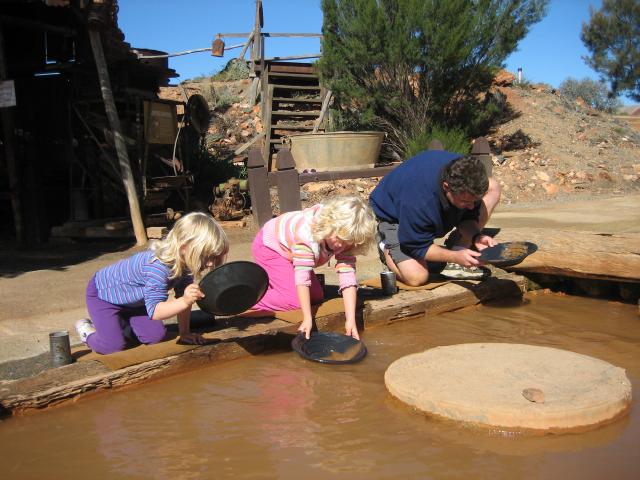
June 1, 2006
From Kalgoorlie we entered the famous Australian Outback. What the heck does that mean? That means that we drove very long distances between any sight of civilization (200-400 km, or about 125 to 250 miles). We were driving on dirt roads that were peppered by dead kangaroos. I think that’s the definition of the Outback—long stretches of dirt roads that have kangaroo carcasses littering the sides of the road. Plus no water. Oh, and no sign of life at all. Plus no mobile phone coverage. Plus no TV. Yeah, that’s the Outback—Long roads peppered with kangaroo carcasses, no phones, no TV, no water. I think that’s called “Mars” with kangaroos; or Namibia.
And there are alien sightings and crop designs every night in the Outback fields.
OK, I made up this last part, mostly because there are no crops in the outback. But also because there aren’t alien sightings.
Or are there?...

So we drove through the authentic Australian Outback. Man, there were a lot of flies. These flies are sticky—they get in your eyes, your nose and your ears. We made fun of the westerners that came to the Outback and bought the mesh screen that encompassed their heads. By about the third minute we arrived in the Outback, we were not only prepared to don the mesh screening, but I was prepared to mesh the car, the suitcases, and to mount an all-out attack on the flies with a flame thrower.
Where are these flies coming from? What are their food sources? Apparently the stray humans are a good food source, as I don’t see any other living thing around us. There’s very little poop in the Australian Outback.
We stopped for the night at a town called Leonora (pop. 530). They boasted two pubs, one restaurant, and one small grocery store. At least they have their priorities right.
The town of Leonora is about 2km away from an authentic Australian Ghost Town—Gwalia.
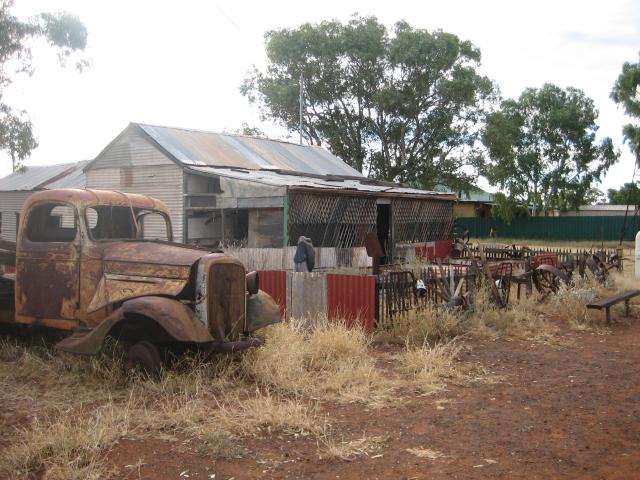
Now this is the full scale version of a gold mine ghost town. Picture this: you’re a young lad and you want to make it rich in the outback of Aussie land. They just struck gold in Gwalia and you head over there to work in the mine because you heard that all the mine workers smuggle a little bit of gold out each day. When you arrive you’re hired in the mine of Gwalia which boasts about 3,000 people. Life is good for a while, although you’re not getting rich because you drink what you earn. There’s very little for a young man to do in these gold towns. But you manage to smuggle a bit of gold each day to add to your bank, as well as a small bit of gold to bribe the inspector that feels/inspects your clothes and body for anything that might be smuggled out of the mine, unless you’re into body cavity searches.
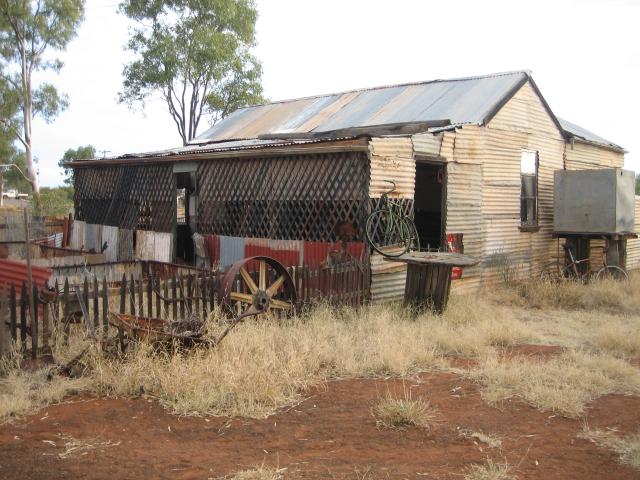
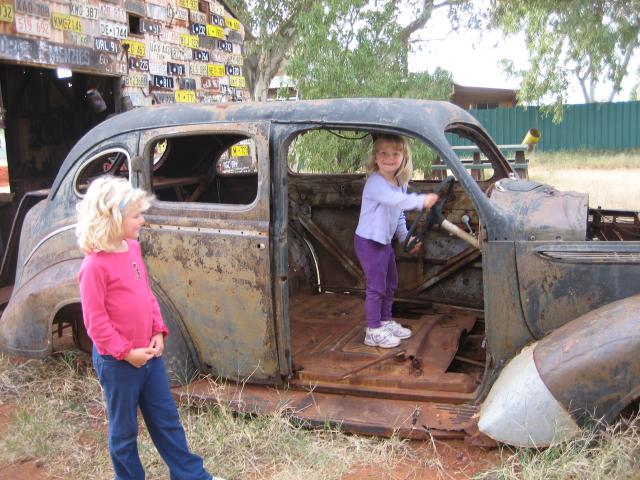
Then the mine runs dry. In 30 days, the town of Gwalia goes from 3,000 people to about 150. Talk about clearing a room—this is like my younger brother walking into a party after eating Mexican food.
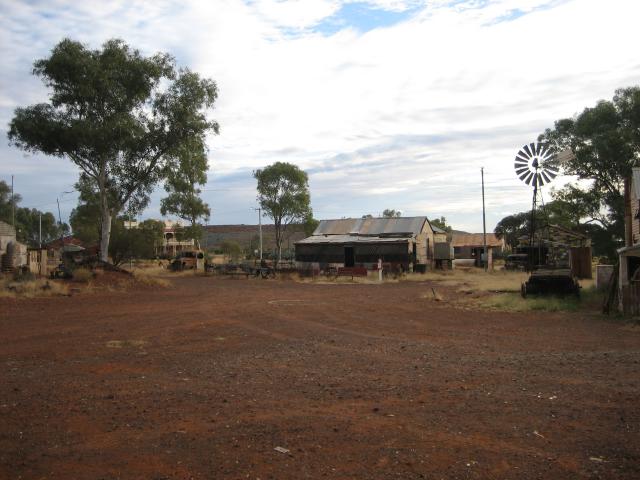
The town of Leonora is so small that there were only 2 restaurants that we could go to. One was a bar; the other was a bar/restaurant. We went to the latter and couldn’t find a place to sit that was outside of the bar. I walked into the bar and saw that it was “Skimpy” night. This means that the waitresses walk around in their underwear. While I usually encourage this type of behavior, I thought that letting my children see this might get me a short visit behind bars. So after gawking at the scantily-clad female for about 12 minutes, we opted to go to the local gas station and buy a loaf of bread and some peanut butter and jelly.
June 2, 2006
From the metropolis that was Leonora, we drove four hours to a farm stay called Wondingnong about 50 min. outside of Mount Magnet (pop. 600). This was a night at a sheep farm. The entire 300,000 acres (about 468 sq. miles) were populated by sheep and scrub brush. And we arrived during a sheep delivery:
Video: Sheep off truck
Man, what a smell. And noise. And craziness. The dogs were going crazy because they’re trained to get the sheep into whatever small opening they see. They love it.
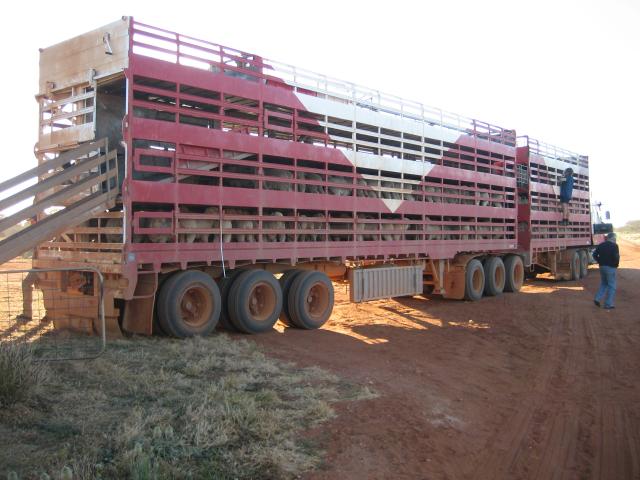
The owners treated us to a tea and damper. It’s pronounced “Tea and dampah.” Dampah means bread that is cooked in an underground cast iron pot that is heated by coals. Very cool; very Outback. Very many flies.
Our stay here was memorable by finally getting a fire started in their outdoor barbeque grill, getting it to a roaring stage (the Australian wood is equal in quality to the South African wood—i.e. it is dry and burns for a long time with a wonderful fire). We then set up an outdoor movie theatre because the owners let us borrow “Charlie and the Chocolate Factory.” The night was cold, but we sat by the huge fire and it was a really great night.
This was one of those nights that we had to split up the kids. Mommy is the favorite parent with which to sleep, which causes me no harm at all because often times I get to sleep by myself. But on this particular night Mommy slept with Annette, and Dominique slept with me, which are the normal sleeping arrangements. And we’re all relatively happy with that.
June 3, 2006
Today we drove about seven hours (yikes!) to Wooleen, another farm stay. This cattle farm had 500,000 acres (about 781 sq. miles!!!)! How do you patrol your cows? Answer: you don’t. You see your cows about once a year. You make sure they have access to clean water and plenty of edible grass/plants/shrubs and occasionally you put out rolls of hay. Once a year you take an inventory and gather up the cows that are able to be slaughtered. You add all the newborns that you find to the inventory, and I have to assume that there are many that are unaccounted for either because you can’t find them, or they are not findable (i.e. they’re dead and eaten by dingoes, which are wild dogs).
These guys are so remote that not only do they provide for their own power via generators and backup battery power, but they also “drive to town” via a small single-prop plane. They have their own blacksmith shop, about 8 trucks and a huge diesel generator with backup battery power.
These guys are so remote that they have their own weather patterns.
They’re so remote that they create their own television programs.
These guys are so far out from anyone else that a trip to the store requires GPS coordinates and time tables.
OK, I kid... But these guys are pretty freakin’ out there.
I need to mention how tough these Outback Australians are. They self-sufficient in their food, electricity, water and transportation. These guys are tough. Their cars are tough—most of them are 4 wheel drive trucks that are jacked up about 6 inches higher than in the states. They have kangaroo bars welded to the front so that when they plow into a 150 pound kangaroo on the road at night, they do little to no damage to their car. In the States we have 18 wheeled big rigs; in Australia they have 62-wheeled road trains. No exaggeration—they tow up to 4 trailers with one truck. Each trailer has between 12 – 24 tires and the entire “train” is about 50 meters long. I think their big rigs are made from old army tanks.
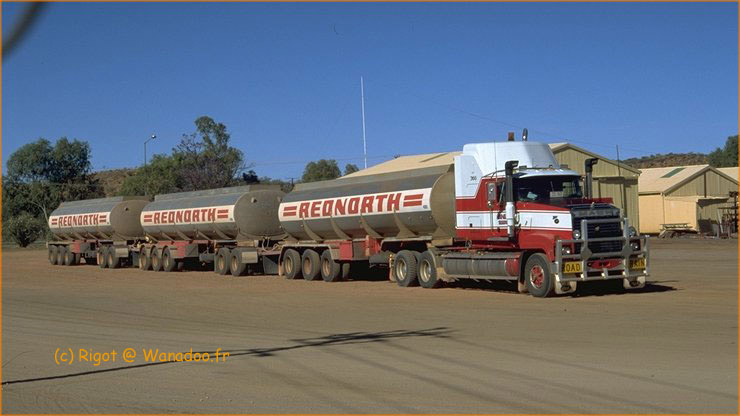
Even their baby strollers are tough. They all have jacked up extra large wheels, and come with solar panels, a CB radio, a spare tire, and 35 gallon water tank in case the baby is lost in the outback.
Outback Aussies live very hard lives, but they have a very low-key approach to life. Nothing is a big deal to them. No worries mate. Things that would make you or me yell in pain or frustration just get ignored by the Aussies. I swear the following story is true—I saw it with my very two eyes and there is no hyperbole at all:
We were at a farm station and I was watching the farmer cut some logs with a chain saw. He was distracted for a minute and the chain saw bucked and came down on this arm, nearly severing his left limb from his body. He calmly put down the chain saw, exclaimed, “Crikey!” and walked slowly to the barn, holding his near-severed limb to stop the flow of blood. He grabbed a tube of liquid cement and attached is limb back to his body. He smiled at me and said, “No worries mate. Good as new.”
That’s a tough dude. I would not like to meet him in a dark alley, or any kind of alley. You have to be tough when the nearest doctor is 4-6 hours away, which means that your closest supply of psychotropic drugs is 4-6 hours away. But they drink a lot over here so I think that might dull the pain a bit.
June 4, 2006
Today was an easy four hour drive through the Australian Outback. Driving through the Outback is quite a pleasant and scenic tour, if you close your eyes and think about, uh… just about anywhere else on earth. Except Namibia. And New Jersey.
We arrived at a place called Carnarvon (Ca `nar von). We were pronouncing it `Car na von. Then we were laughed at for being stupid Americans and had honey pasted on us and left in the Outback for the flies. Actually, this was a nightmare of mine, and it wasn’t very funny…
We stayed in a permanent camper, which means that they bought a 30 year old small camper from someone, bolted it to a concrete pad, added a small outdoor shed to it, and called it a cabin. It wasn’t horrible, but it was well-used. It was so well used I thought that it should have come with complimentary antibiotic shots, or at least a gallon of orange juice and a bottle of Echinacea.
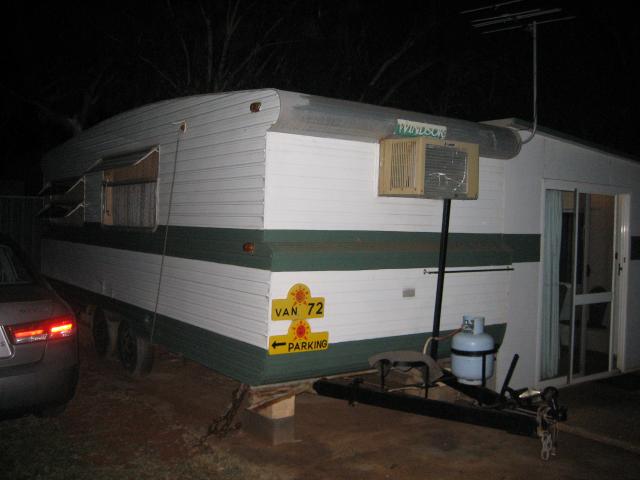
June 5, 2006
About a three hour drive to the coast to Exmouth and another caravan park. Although this one was vastly different—no mobile phone coverage (it was about 30 min outside of Exmouth, pronounced Ex-mouth, not Ex-muth), and although we had an en-suite unit (meaning it’s supposed to have a bathroom), the bathroom was located outside of the living unit. Plus the unit was pretty dirty and a bit on the disgusting side.
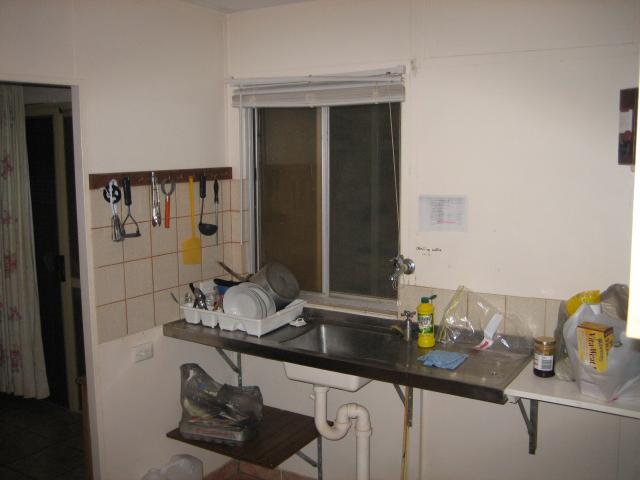
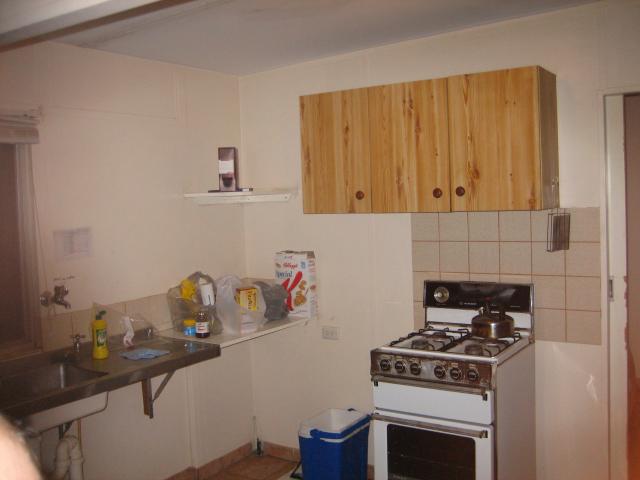
But the campground did come with its own 4’ long monitor lizard for which we did not have to pay extra. This lizard entertained us in a way that a live crocodile on the end of your deck with an eye for your femur will entertain you.
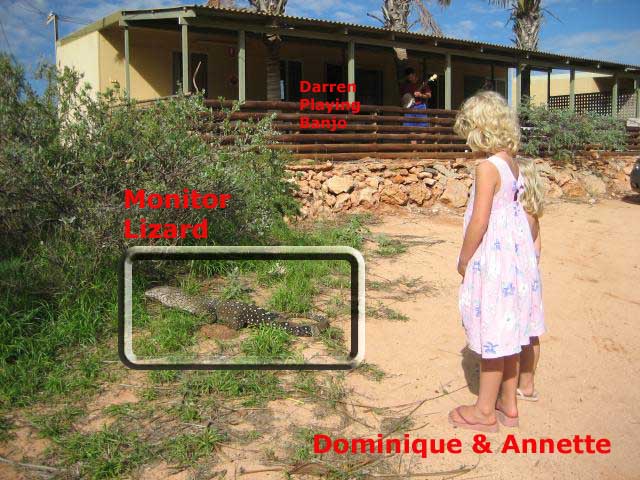
We took a tour of the reef on a glass bottom boat. Not very cool you think? Verily, I say differently. This was a tour that exceeded my heretofore extremely low expectations. Skipper Alec was very informative and he really made our 2 hr. long boat trip a pleasure. He’s lived and worked all around the world, been educated in the US (one of the “M” states—Minnesota, Mississippi, Michigan, Milwaukee, Muscogee, Mile High Stadium…, I get these places confused). He was such a captivating speaker that connected with his audience that I was immediately enthralled by the entire Ningaloo reef.
Dominique and I snorkeled in the testicle-hibernating water. I refer to the temperature of the water as testicle-hibernating because of two reasons:
- The water was a cool 26.6 degrees C, or 80 degrees F, the “F” here stands for “Frickin’ Cold!”
- The water was infested with jellyfish and sharks. Skipper Alec said that the jellyfish here were benign, but that’s like saying a tumor is benign—it’s still something that you don’t want to see. But I admit to being “jellyman” and playing with the jellies by poking them on their tops. They are very gelatinous; I always wanted to use that word in a coherent sentence.
Actually, I snorkeled and saved Dominique from a traumatic snorkeling experience when she joined me in the water for about 10 seconds, tried to use the snorkel and didn’t understand that she couldn’t breathe from her nose, then gave up and wanted to go back to the boat. They should call it “Don’t breathe from your nose” diving instead of snorkeling. It’s much more descriptive.
That’s understandable, especially for a six year old girl that’s just learning to swim. Breathing when you’re under water is difficult even when you’re an adult. It’s just not natural. It’s just like I was telling Nicky the other day, “Breathing underwater is very difficult to do. Like Fire-breathing. The key when swallowing fire is to breathe OUT. If you breathe in, then you’re in trouble.”
June 7, 2006
We’re on our way to Coral Bay, a big tourist hangout. but for the life of me I don’t understand why. Yes, it’s on the beach. But there are only 3 places in which to stay, a poorly-stocked grocery store, and very poor service. And it’s about 50 km away from any other place of civilization. But I guess it’s the draw of the beach. We stayed at a caravan park that charged extra for blankets, toilets, water and they even charged extra for breathing. They nickeled and dimed us to death, especially since I didn’t pay for the breathing part. I figured that we could sneak that in without them knowing about it.
I guess the draw here is the name. I mean if they named the place, “Zit Island” or, “Contagious Inlet” then they probably wouldn’t get the same demand in visitors as, “Coral Bay.” Chalk one up for those marketing geniuses…
June 8, 2006
We returned to Carnarvon because we were headed south to Perth to catch our flight in about 8 days. If you’re visually inclined, our Western Australia adventure started in Perth which is about 7 o’clock on the face of the continent. Then we went inland eastward to Kalgoorlie, almost 600 km (about 372 miles). Then we went Northwest through the Outback until we arrived in Carnarvon, then we went north to Exmouth (about 11 o’clock on the face of the continent), and now we double-backed on our southward trip to Perth, stopping once again at Carnarvon.
We stayed at WinterSun caravan park, the same campground as before, but in better accommodations. Remember the first time we stayed at a camper that was bolted to the cement; now we stayed at a prefabricated villa that was bolted to the cement. But it was a huge upgrade because it was cleaner, newer, and didn’t come with biohazard warnings. Plus it came with the Australian channel SBS, which showed the World Cup Soccer games.
We followed the World Cup because both Nicky and I love soccer. I played a fair amount of it through the ages and we fell in love with the game at the professional level during our honeymoon in 1990 when we followed England to an exciting but a disappointing semifinal finish.
We followed the Australian Soccer Team, The Socceroos. Yes, it’s in first place for the worst name on the planet. But these guys played extremely well, exceeded everyone’s expectations at the 2006 World Cup, and they were darn fun to watch. What was especially impressive was that Australia’s last visit to the World Cup was about 30 years ago! Now, in 2006, they fielded their first team in 30 years and they make it to the round of 16 teams! That’s incredibly impressive, and again, very fun to follow.
For U.S. fans, it’s sad to say that our fellows in red, white and blue didn’t make it out of the first round of 64. That’s a bit disappointing, but we might relish the fact that they had Italy in their group who went on to win the World Cup…
OK, USA sucked. I’m grasping at straws…
June 9, 2006
Today was an errand day--email, internet stuff, haircuts, laundry, receive tetanus boosters from playing around the rusty playground area. The normal stuff that you associate from long-time travel mixed with housekeeping.
Nicky met a family from New Zealand that’s traveling for 4-6 yrs through Australia! Man, these guys are crazy. We’ve met so many people so far that travel for 4+ months. I tell you, the American people are way behind the travel curve.
Neville, Elaine and Alan have been traveling for about 3 years in a caravan (i.e. camper) all through Australia. He’s from New Zealand and he had a coffee business that he sold and now he’s traveling on the proceeds of the sale. Fortunately, not only is this guy incredibly friendly and he shared some of his home-grown coffee with us, but he’s going to be back in his hometown in New Zealand at the same time that we’re gonna be in NZ. So we’ve planned to hookup and spend some time together.
Since Neville is in the coffee business, I’m hoping that he can explain to me why Starbucks does not offer a small cup of coffee. Grande, Venti and Venti-Grande is about all I can understand about the Starbucks line of coffee. I figure it is coffee by intimidation—nobody can understand the menu, so people just pick out key words and phrases from the menu board and they hope that it makes sense to the barristers (see, there they go again--fancy word for “coffee makers”).
Today Dominique and I visited the OTC Dish Base in Carnarvon, a 29.5 meter diameter reflector dish which was the first antenna in Australia to transmit and receive world-wide television via satellite. It was also Australia's first earth station for satellite tracking and communications, and one of just eight in the world. Established in 1966 by NASA, the station was involved in the Gemini and Apollo space missions, and played a role intercepting Haley's Comet. How cool is that?! This out-of-the-way place with unbelievable access to clear skies was integral in the US Space Program.
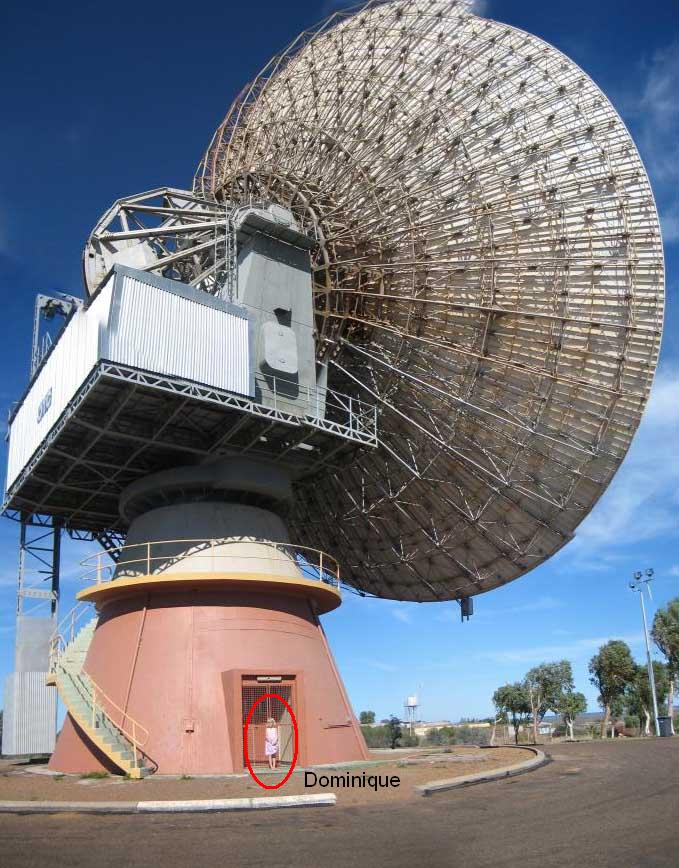
The site was closed in 1987 and they have not done a good job of making this an historical and/or educational site. It’s available to the public but we can only walk around it and climb up to the first level which is about 20 feet up. There’s no historical facts, no educational placards here at all. That was pretty frustrating, and sad.
June 10, 2006
Race Day in Carnarvon! This is a big day in Carnarvon, a city of about 2,500 people. It’s Ladies’ Day at the Carnarvon Races, which means that the ladies get in free.
Or it USED to mean that the ladies get in free. Actually I think it means, “Please bring any and all ladies because they’ll get in free. Now that you’re at the gate paying for tickets, ladies don’t really get in free at all. We just called it Ladies Day to get you to come here and look awkward at the ticket gate when we tell you that ladies don’t get in free.” So they should have called it, “Look awkward day at the gate when we tell you that ladies don’t get in free” day.
During the races they had a fashion show, some kind of contest that the ladies entered to see who was the best dressed. I never realized how manly many of these Australian women were, or at least the Carnarvon brand of women. Well, maybe not manly, and maybe not homely, just darn unattractive, despite their high heels, the wide-brimmed hats and their fake stoles. But they drink a lot of beer—maybe that’s their problem.
We stayed at Carnarvon for three days, all of which were used to do mundane things like haircuts, laundry and shopping. A good place to regroup.
June 11, 2006
Today is a travel day as we continue our southward trek towards Perth. We drove to Monkey Mia, where there are no monkeys but several emus that prowl the campground for food. This is actually a pretty cool feature of the park. They have a family of emus that walk in and out of people’s campsites looking for food. Emus look like a smaller version of ostriches, with hair instead of feathers. Quite the popular large bird in WA; in fact Nicky almost hit a couple as she was driving in the outback.
Monkey Mia is famous for the dolphins. They have a pod of dolphins that come to the beach every morning to get some food from the Monkey Mia staff. Don’t really know how this started, but they do a good job of educating the guests about the dolphins, preach just about the right amount of environmentally sound practices they do here, and give some of the guests a chance to feed the dolphins.
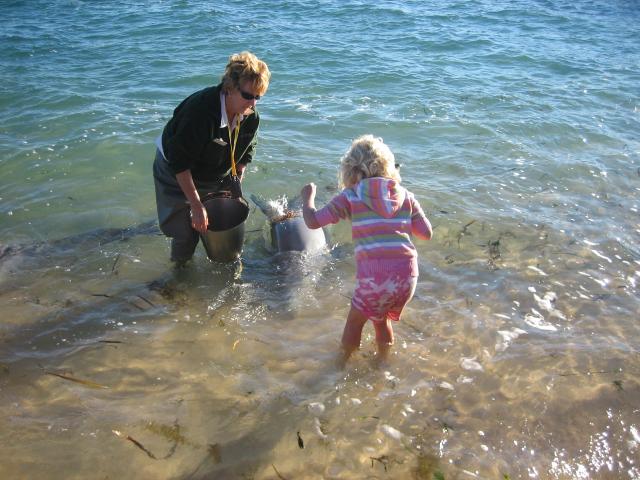
Video: Feeding Dolphins
The rest of the time at the Monkey place was spent w/the girls at the pool playing with kids from two other families. And following the World Cup every night at the bar. We did a short afternoon cruise on a large catamaran that assured us that we would catch spectacular views of the wildlife; instead I think I caught a little sunburn.
June 14, 2006
Today we drove further south to a large town/small city called Geraldon. But we had two quick stops before we hit the road for the 4 hour drive: Shell Beach and a quick trip to see the Stromatolites.
Shell beach is a place that washes up billions of small shells on its shores. The shores run for miles and the shells are several feet deep over a “beach” that’s at least 50 meters wide. The local scientists aren’t quite sure why this occurs here, and there’s a shell-processing plant to takes these shells by the truckload and does something with them (I can’t remember what exactly they use them for). But this is a bit of a weird place. A beach that, instead of sand, has small shells. An infinite supply of small shells.
I can’t think of anything funny or sarcastic to say about this.
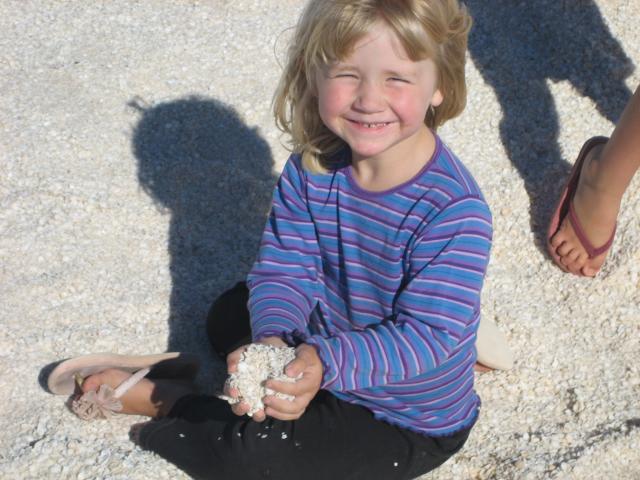
We then made a quick stop to see the stromatolites. The stroma-who-ha you ask? Why, these are only the oldest living things on the planet. Some scientists believe they were the first living things on mother earth born 3.5 billion years ago. Hamelin Pool at the base of Shark Bay in W.A. is the location of the best example in the world of living marine stromatolites. The water of Hamelin Bay is twice as saline as usual sea water because of a bar across the Bay's entrance and rapid evaporation from the shallow water. Most living animals which feed on the bacteria and algae of which stromatolites are composed cannot tolerate such saline conditions. As a result stromatolites can grow here successfully, undisturbed. Most stromatolites are extremely slow growing. Those in Hamelin Pool grow at a maximum of .3mm a year, so those which are up to a meter high are hundreds if not thousands of years old.
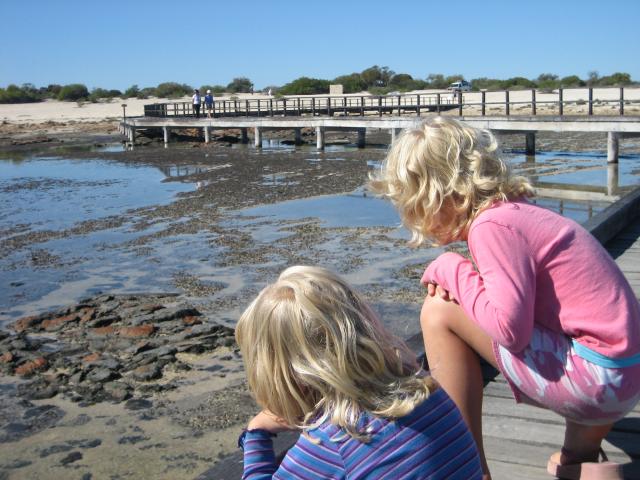
They played an important role in the history of the earth because they contribute oxygen to the earth's atmosphere, which allowed many of the air-breathing animals to appear. The organisms which construct stromatolites are photosynthetic. They take carbon dioxide and water to produce carbohydrates, and in doing this they expel oxygen into the atmosphere.
It’s kinda like the opposite of making beer—yeast eat the carbohydrates (sugar) and produce carbon dioxide. Stromatolites eat carbon dioxide and water and make carbohydrates and exhale oxygen. So if you think about it, the stromatolites are anti-beer. I have friends that would be very angry at this if they knew about it…
On the way we had to fill up with petrol (that’s Australian for gas) and pay the obligatory $70 AUD to fill up. Yes, that’s not a typo. The price of gas here is almost four times what it is in the States.
Anyway our credit card got declined and it was yet another painful international collect call to our bank. It seems that someone had stolen our credit card number, created new cards from the information, sold it to someone in Italy where they purchased $3,200 in leather goods and attempted to purchase about $3,500 in household goods. They were successful in the former, and the bank automatically declined the latter. We weren’t liable for the fraudulent charges, but we did have to cancel that card and get a new one sent to us. Bit of a pain with traveling, lack of a proper address, and poor communications devices, but with my father’s help and $65 to FedEx, we received the new card about 10 days later.
That was a bit scary because we don’t have any idea how these guys got our information, so we don’t know how to better protect ourselves from this in the future. I guess someone has to eat the $3,200, but fortunately it’s not us.
June 15, 2006
A quick and disappointing tour of a wind farm. These things are eerie. It’s like something out of the x-files. It was disappointing because there wasn’t much there except for a dozen or so massive windmills. These were pretty cool to look at, but I was hoping for a tour that would allow us inside the mills, see the generators, etc.
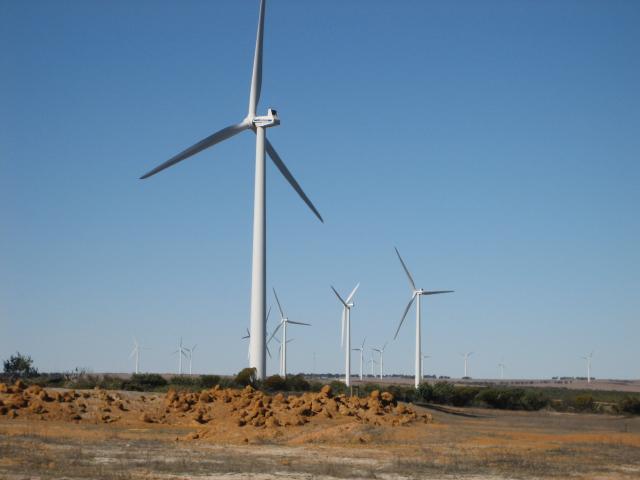
We stayed at a caravan park that had a several kangaroos as pets. This was very cool because to this point, we really hadn’t seen many kangaroos, and certainly none up close unless you count the dead ones on the side of the road in the outback. But really, live kangaroos are so much more interesting than the dead kind, don’t you think?
The girls got to feed them and we got to pet a baby ‘roo, called a Joey. A baby ‘roo is called a Joey even if it’s a girl. No wonder so many of them are in therapy.
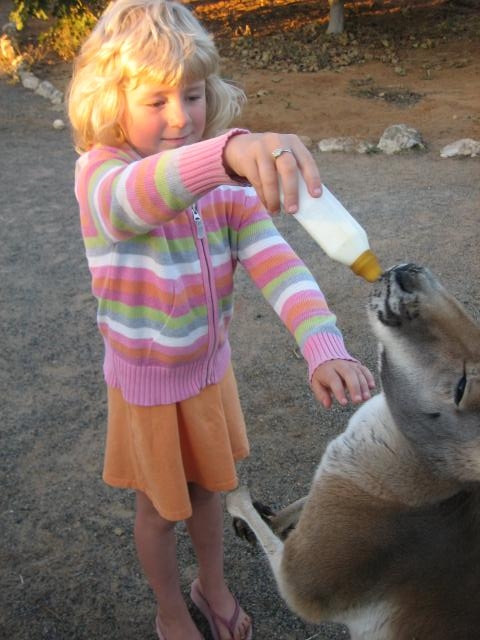
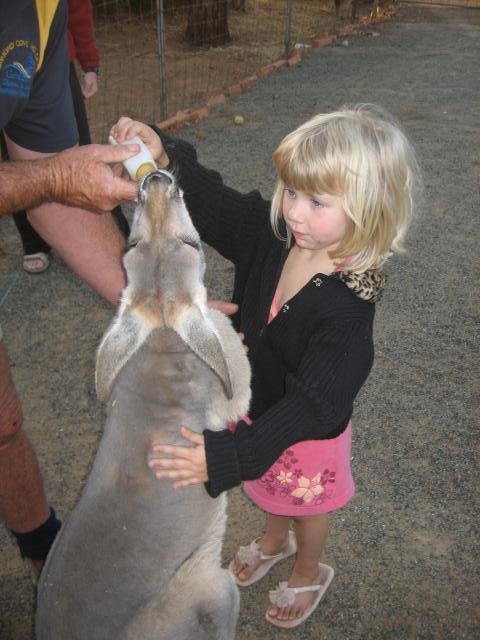
Video: Feeding 'Roos'
Video: Baby Joey
June 16, 2006
Flight from Perth to Cairns today. Pretty painful flight actually because it didn’t leave until 10:30 pm and we arrived in Cairns at 4:30am. This was a difficult flight, especially with the kids. But we stayed at an awesome campground in Cairns that had kids and Cassowaries! A bit smaller than ostriches, cassowaries are Australia’s largest bird; it has a distinctive bright blue head and very large claws on their feet which makes their job of disemboweling you much easier
|